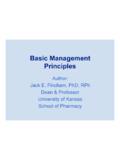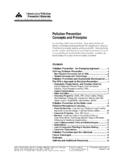Transcription of The 14 Principles of the Toyota Way: An Executive Summary ...
1 Since Toyota s founding we have adhered to the core principle of con-tributing to society through the practice of manufacturing high-qualityproducts and services. Our business practices and activities based on thiscore principle created values, beliefs and business methods that over theyears have become a source of competitive are themanagerial values and business methods that are known collectively asthe Toyota Way. Fujio Cho, President Toyota (from the Toyota Way document, 2001)The Toyota Way Is More than Tools andTechniquesSo you set up your kanban system. (Kanban is the Japanese word for card, ticket, or sign and is a tool for managing the flow and production ofmaterials in a Toyota -style pull production system.) You plug in theandon, which is a visual control device in a production area that alerts workers todefects, equipment abnormalities, or other problems using signals such as lights,audible alarms, etc.
2 Finally, with these devices your workplace looks like a Toyotaplant. Yet, over time your workplace reverts to operating like it did before. You callin a Toyota Production System (TPS) expert who shakes her head is wrong? The real work of implementing Lean has just begun. Your workers do notunderstand the culture behind TPS. They are not contributing to the continuousThe 14 Principles of the Toyota Way:An Executive Summary of theCulture Behind TPSC hapter 10/29/2003 9:15 AM Page 35improvement of the system or improving themselves. In the Toyota Way, it s thepeople who bring the system to life: working, communicating, resolving issues,and growing together. From the first look at excellent companies in Japan practic-ing lean manufacturing, it was clear that the workers were active in makingimprovement suggestions.
3 But the Toyota Way goes well beyond this; it encour-ages, supports, and in fact demands employee involvement. The more I have studied TPS and the Toyota Way, the more I understand thatit is a system designed to provide the tools for people to continually improve theirwork. The Toyota Way means more dependence on people, not less. It is a culture,even more than a set of efficiency and improvement techniques. You depend uponthe workers to reduce inventory, identify hidden problems, and fix them. Theworkers have a sense of urgency, purpose, and teamwork because if they don t fixit there will be an inventory outage. On a daily basis, engineers, skilled workers,quality specialist, vendors, team leaders, and most importantly operators areall involved in continuous problem solving and improvement, which over timetrains everyone to become better problem solvers.
4 One lean tool that facilitates this teamwork is called 5S (sort, stabilize, shine,standardize, sustain, discussed in Chapter 13), which is a series of activities foreliminating wastes that contribute to errors, defects, and injuries. In this improve-ment method, the fifth S, sustain, is arguably the hardest. It s the one that keepsthe first four S s going by emphasizing the necessary education, training, andrewards needed to encourage workers to properly maintain and continuouslyimprove operating procedures and the workplace environment. This effortrequires a combination of committed management, proper training, and a culturethat makes sustaining improvement a habitual behavior from the shop floor tomanagement. This chapter provides a synopsis of the 14 Principles that constitute theToyota Way.
5 The Principles are organized in four broad categories: 1) Long-TermPhilosophy, 2) The Right Process Will Produce the Right Results (this utilizesmany of the TPS tools), 3) Add Value to the Organization by Developing YourPeople, and 4) Continuously Solving Root Problems Drives OrganizationalLearning. Note that Part II of this book is also organized into these same four cat-egories the four P s of the Toyota Way model in Chapter 1. In the followingtwo chapters, I will demonstrate some of these 14 Principles at work in the devel-opment of Lexus and Prius. If you would like to jump ahead to begin the detaileddiscussion of these 14 Principles , you can skip to Chapter 7 now. However, I doadvise that you peruse the Principles Toyota 10/29/2003 9:15 AM Page 36 Executive Summary of the 14 Toyota Way PrinciplesSection I: Long-Term PhilosophyPrinciple 1.
6 Base your management decisions on a long-term philosophy,even at the expense of short-term financial goals. Have a philosophical sense of purpose that supersedes any short-termdecision making. Work, grow, and align the whole organization toward acommon purpose that is bigger than making money. Understand yourplace in the history of the company and work to bring the company tothe next level. Your philosophical mission is the foundation for all theother Principles . Generate value for the customer, society, and the economy it is yourstarting point. Evaluate every function in the company in terms of itsability to achieve this. Be responsible. Strive to decide your own fate. Act with self-reliance andtrust in your own abilities. Accept responsibility for your conduct andmaintain and improve the skills that enable you to produce added value.
7 Section II: The Right Process Will Produce the Right ResultsPrinciple 2. Create a continuous process flow to bring problems to the surface. Redesign work processes to achieve high value-added, continuous to cut back to zero the amount of time that any work project is sit-ting idle or waiting for someone to work on it. Create flow to move material and information fast as well as to linkprocesses and people together so that problems surface right away. Make flow evident throughout your organizational culture. It is the keyto a true continuous improvement process and to developing 3. Use pull systems to avoid overproduction. Provide your downline customers in the production process with whatthey want, when they want it, and in the amount they want. Materialreplenishment initiated by consumption is the basic principle of just-in-time.
8 Minimize your work in process and warehousing of inventory by stock-ing small amounts of each product and frequently restocking based onwhat the customer actually takes away. Be responsive to the day-by-day shifts in customer demand rather thanrelying on computer schedules and systems to track wasteful 4. Level out the workload (heijunka). (Work like the tortoise, notthe hare.)The 14 Principles of the Toyota 10/29/2003 9:15 AM Page 37 Eliminating waste is just one-third of the equation for making lean suc-cessful. Eliminating overburden to people and equipment and eliminat-ing unevenness in the production schedule are just as important yetgenerally not understood at companies attempting to implement leanprinciples. Work to level out the workload of all manufacturing and service process-es as an alternative to the stop/start approach of working on projects inbatches that is typical at most 5.
9 Build a culture of stopping to fix problems, to get quality rightthe first time. Quality for the customer drives your value proposition. Use all the modern quality assurance methods available. Build into your equipment the capability of detecting problems andstopping itself. Develop a visual system to alert team or project leadersthat a machine or process needs assistance. Jidoka(machines with humanintelligence) is the foundation for building in quality. Build into your organization support systems to quickly solve problemsand put in place countermeasures. Build into your culture the philosophy of stopping or slowing down toget quality right the first time to enhance productivity in the long run. Principle 6. Standardized tasks and processes are the foundation for con-tinuous improvement and employee empowerment.
10 Use stable, repeatable methods everywhere to maintain the predictability,regular timing, and regular output of your processes . It is the foundationfor flow and pull. Capture the accumulated learning about a process up to a point in timeby standardizing today s best practices. Allow creative and individualexpression to improve upon the standard; then incorporate it into thenew standard so that when a person moves on you can hand off thelearning to the next person. Principle 7. Use visual control so no problems are hidden. Use simple visual indicators to help people determine immediatelywhether they are in a standard condition or deviating from it. Avoid using a computer screen when it moves the worker s focus awayfrom the workplace. Design simple visual systems at the place where the work is done, to sup-port flow and pull.







